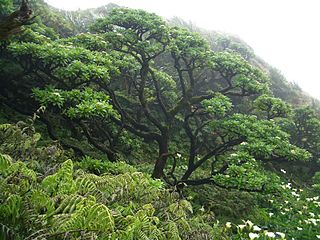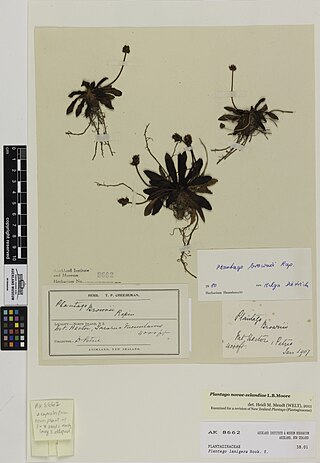
Plantago is a genus of about 200 species of flowering plants in the family Plantaginaceae, commonly called plantains or fleaworts. The common name plantain is shared with the unrelated cooking plantain. Most are herbaceous plants, though a few are subshrubs growing to 60 centimetres tall.

Plantaginaceae, the plantain family, is a large, diverse family of flowering plants in the order Lamiales that includes common flowers such as snapdragon and foxglove. It is unrelated to the banana-like fruit also called "plantain." In older classifications, Plantaginaceae was the only family of the order Plantaginales, but numerous phylogenetic studies, summarized by the Angiosperm Phylogeny Group, have demonstrated that this taxon should be included within Lamiales.

Plantago major, the broadleaf plantain, white man's footprint, waybread, or greater plantain, is a species of flowering plant in the plantain family Plantaginaceae. The plant is native to Eurasia.

Plantago media, known as the hoary plantain, is a species of flowering plant in the plantain family Plantaginaceae. It is native to central and western Europe, including Great Britain and introduced to parts of the north-east United States. Its generic name is derived from the Latin for sole; like other members of the genus Plantago, it should not be confused with the unrelated plantain, a starchy banana.

The flora of Saint Helena, an isolated island in the South Atlantic Ocean, is exceptional in its high level of endemism and the severe threats facing the survival of the flora. In phytogeography, it is in the phytochorion St. Helena and Ascension Region of the African Subkingdom, in the Paleotropical Kingdom.

Plantago maritima, the sea plantain, seaside plantain or goose tongue, is a species of flowering plant in the plantain family Plantaginaceae. It has a subcosmopolitan distribution in temperate and Arctic regions, native to most of Europe, northwest Africa, northern and central Asia, northern North America, and southern South America.
Plantago moorei, also called Moore's plantain, is a species of plant in the family Plantaginaceae. It is endemic to Falkland Islands. Its natural habitat is temperate shrubland. It is threatened by habitat loss.

Plantago rugelii is an edible species of flowering plant in the plantain family, Plantaginaceae. It is native to North America, where it occurs in eastern Canada and the central and eastern United States. Its common names include American plantain, blackseed plantain, pale plantain, and Rugel's plantain. The species name rugelii honors Ferdinand Ignatius Xavier Rugel (1806-1879), a German-born botanist and pharmacist.

Plantago hookeriana, commonly called Hookers plantain, is a species of flowering plant in the plantain family (Plantaginaceae). It is native to Texas and Louisiana in the United States. It is typically found in disturbed sandy areas.

Plantago hedleyi is a species of flowering plant in the plant family Plantaginaceae that is endemic to Lord Howe Island, Australia. Joseph Maiden described P. hedleyi in 1914. Plants of this plantain are large with large leaves, up to nine veins, wide petioles, and long spikes with dozens of flowers and fruits with up to 5 seeds.

Plantago aucklandica is a species of flowering plant in the family Plantaginaceae that is endemic to the subantarctic Auckland Islands, New Zealand. Joseph Dalton Hooker described P. aucklandica in his Flora Antarctica in 1844. Plants of this plantain are large with large leaves, up to seven veins, wide petioles, colliculate seeds, and long spikes with dozens of flowers and one-seeded fruits. This species in considered to be At Risk - Naturally Uncommon, as it is an island endemic with a restricted range.

Plantago indica, commonly known as branched plantain, sand plantain, or black psyllium, is a flowering plant in the plantain family Plantaginaceae, and is one of a few species in the Plantago genus under the common name psyllium. The plant is native to parts of Africa, Europe, Russia, and Asia, and has been naturalized in many other areas such as Australia and North America. The plant can be found mostly in dry inland areas, such as those that are sandy, and has also naturalized on roadsides and in meadows. The plant is not used broadly as a food source, but has been cultivated for its seeds which serve a medicinal use as a laxative.

Plantago stauntonii is a species of flowering plant in the family Plantaginaceae that is endemic to Île Amsterdam and Île Saint-Paul in the French southern territories. Sir Heinrich Wilhelm Reichardt described P. stauntonii in 1871, naming it after Sir George Leonard Staunton, who collected specimens of it in 1793.

Plantago obconica is a species of flowering plant in the family Plantaginaceae that is endemic to the South Island of New Zealand. William Sykes described the species in 1988. It is the smallest Plantago species in New Zealand. Plants of this species of plantain are perennial with a rosette habit, with very narrow, linear, keeled leaves, and fruiting capsules with a 1-cm long funnel-like base.

Plantago unibracteata is a species of flowering plant in the family Plantaginaceae that is endemic to New Zealand. Knud Rahn gave the species its current name in 1996, based on Joseph Dalton Hooker's original description in 1854. Plants of this species of plantain are perennial with a rosette habit, with narrowly angular-ovate leaves with few teeth, and numerous angular or rounded seeds.

Plantago lanigera is a species of flowering plant in the family Plantaginaceae that is endemic to New Zealand. Joseph Dalton Hooker described P. lanigera in 1864. Plants of this species of plantain are perennial with a rosette habit, leaves widest above the middle, few small angular to rounded seeds per capsule, glabrous bracts and sepals, and punctate leaves. It is listed as Not Threatened.

Plantago novae-zelandiae is a species of flowering plant in the family Plantaginaceae that is endemic to New Zealand. Lucy Moore described P. novae-zelandiae in 1961. Plants of this species of plantain are perennial with a rosette habit, leaves widest above the middle, up to 4 ellipsoid seeds per capsule, glabrous bracts and sepals, and punctate leaves. It is listed as Not Threatened.
Plantago picta is a species of flowering plant in the family Plantaginaceae that is endemic to New Zealand. William Colenso described P. picta in 1890. Plants of this species of plantain are perennial with a rosette habit, leaves widest above the middle, up to 5 ellipsoid seeds per capsule, and bracts with hairs along the edges but otherwise glabrous. Its conservation status is At Risk – Naturally Uncommon.

Plantago udicola is a species of flowering plant in the family Plantaginaceae that is endemic to New Zealand. Heidi Meudt and Philip Garnock-Jones described P. udicola in 2012. Plants of this species of plantain are perennial with a rosette habit, leaves widest above the middle, seeds uniform, ellipsoid and 1–4 per capsule, edges of bracts sparsely hairy, edges of sepals with isolated hairs at the apex only, and a chromosome number of 2n = 96 (dodecaploid). It is listed as Not Threatened.


















